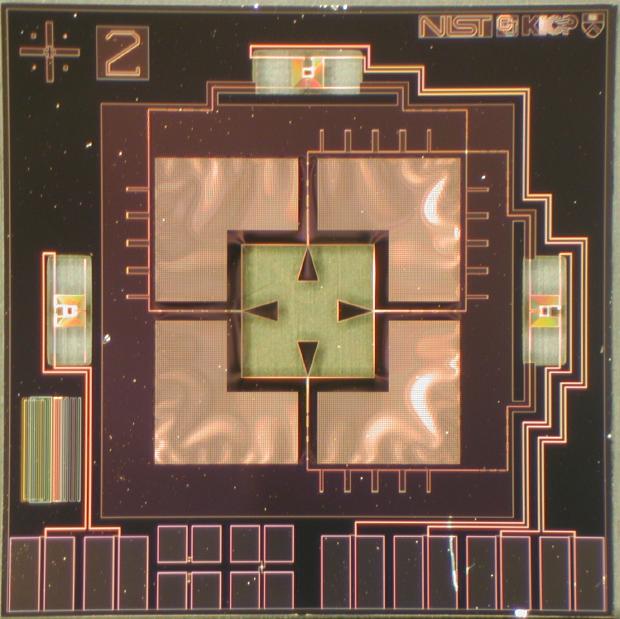The new sensors, described today at the American Physical Society (APS) meeting in Denver, were made for a potentially ground-breaking experiment by a collaboration involving NIST, Princeton University, the University of Colorado at Boulder, and the University of Chicago.
NIST is best known for earthbound measurements but a current project at NIST’s Boulder campus plays a critical role in the study of the cosmic microwave background (CMB)—the faint afterglow of the Big Bang that still fills the universe. This project previously built superconducting amplifiers and cameras for CMB experiments at the South Pole, in balloon-borne observatories, and on the Atacama Plateau in Chile.
The new experiment will begin approximately a year from now on the Chilean desert and will consist of placing a large array of powerful NIST sensors on a telescope mounted in a converted shipping container.

Micrograph of a prototype NIST detector that will be used to seek B-mode polarization, the signature of the rapid inflation of the universe after the Big Bang. Cosmic radiation will be received by the arrow-shaped antennas in the middle of the detector. The antennas separate the radiation into two different polarization directions at a frequency of 145 gigahertz. (All light has two polarization directions.) Finally, the radiation for each polarization will be converted to heat by transition-edge sensors (top and right sides of the image), which precisely measure the energy using a superconducting metal that changes resistance in response to heat. The resulting data will be mapped to identify the polarization patterns. Credit: NIST
The detectors will look for subtle fingerprints in the CMB from primordial gravitational waves—ripples in the fabric of space-time from the violent birth of the universe more than 13 billion years ago. Such waves are believed to have left a faint but unique imprint on the direction of the CMB’s electric field, called the “B-mode polarization.” These waves—never before confirmed through measurements—are potentially detectable today, if sensitive enough equipment is used.
“This is one of the great measurement challenges facing the scientific community over the next 20 years, and one of the most exciting ones as well,” said Kent Irwin, the NIST physicist leading the project.
If found, these waves would be the clearest evidence yet in support of the “inflation theory,” which suggests that all of the currently observable universe expanded rapidly from a subatomic volume, leaving in its wake the telltale cosmic background of gravitational waves.
“The B-mode polarization is the most significant piece of evidence related to inflation that has yet to be observed,” said Ki Won Yoon, a NIST postdoctoral scholar who will describe the project at the APS meeting. “A detection of primordial gravitational waves through CMB polarization would go a long way toward putting the inflation theory on firm ground.”
The data also could provide scientists with insights into different string theory models of the universe and other “unified” theories of physics.
These types of experiments can only be done by studying the universe as a whole, because the particles and electromagnetic fields at the beginning of the inflationary epoch were roughly 10 billion times hotter than the energies attainable by the most powerful particle colliders on Earth today. At this energy scale, fundamental forces now identified as separate are predicted to merge.
“The universe is a physics lab,” Irwin said. “If you look far away, you are actually looking back in time, potentially observing interactions that occurred at energy levels forever out of reach of terrestrial experiments.”
Recent studies of the CMB have focused on measuring slight spatial variations in temperature or power that existed about 380,000 years after the Big Bang. These patterns of radiation allow scientists to characterize the early distributions of matter and energy that evolved into the stars and galaxies of today.
By comparing the measurements to predictions made by various theories, scientists have added to the authoritative history of the universe, narrowing down, for instance, its age (13.7 billion years).
By contrast, the new NIST detectors are designed to measure not only temperature but also the polarization. The B-mode polarization signals may be more than a million times fainter than the temperature signals.
To detect such subtle patterns, the NIST detectors will collect significant amounts of radiation efficiently, and will be free of moving parts and traditional sources of systematic error, such as vibration and magnetic interference, Irwin said. In addition, advanced signal processing and error control will be needed.
The new sensors are prototypes for NIST polarimeter arrays that will greatly increase the sensitivity of future experiments by building thousands of detectors into monolithic units that can be deployed in cryogenic telescope cameras. The new NIST detectors may also have applications closer to home, such as in reducing glare in advanced terahertz imaging systems for detecting weapons and contraband.
As a non-regulatory agency of the U.S. Department of Commerce, NIST promotes U.S. innovation and industrial competitiveness by advancing measurement science, standards and technology in ways that enhance economic security and improve our quality of life.
*Atacama B-mode Search (ABS): Scientific Motivations and Design Overview, Sheraton Denver Hotel, Plaza Court 2, Saturday, May 2, 2009, 1:30 – 1:42 p.m.





Comments